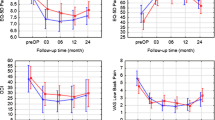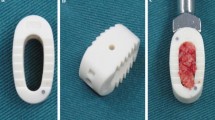Abstract
Problems associated with posterior lumbar interbody fusion (PLIF) have traditionally included the need for donor bone, prolonged healing time of donor bone, the difficulty of cutting precise bony channels, the risk of retropulsion of graft, postoperative collapse of the bone graft, and pseudarthrosis. To avoid these problems a carbon fiber reinforced polymer implant cage has been developed to facilitate interbody fusion. The aim of the present study was to evaluate the technical problems and fusion rate associated with this new device for PLIF. Between April 1991 and December 1993, 65 pairs of these implant cages were sold in Sweden. They were traced to six hospitals, where they had been used in the treatment of 51 patients operated on at a total of 65 levels. All PLIF were supplemented with VSP (Variable Screw Placement) instrumentation. All medical records were evaluated and all patients were examined with plain radiographs taken at least 1 year after surgery. If that investigation did not show a clear fusion they were also evaluated with CT (18 patients, 27 levels). No intraoperative problems with the device have been reported; 44 patients (86%) and 58 levels (89%) achieved successful fusion. All patients bar one maintained their immediately obtained postoperative disc height. CT with 1-mm slices and sagittal reconstruction is most helpful if radiographs are difficult to interpret.
Similar content being viewed by others
References
Berkley LR (1989) A critique of posterior lumbar interbody fusion: 12 years' experience with 250 patients. Surg Neurol 31: 281–289
Blumenthal SL, Gill K (1993) Can lumbar spine radiographs accurately determine fusion in postoperative patients? Correlation of routine radiographs with a second surgical look at lumbar fusions. Spine 18: 1186–1189
Brantigan JW (1994) Pseudarthrosis rate after allograft posterior lumbar interbody fusion with pedicle screw and plate fixation. Spine 19: 1271–1280
Brantigan JW, Steffee AD (1993) A carbon fiber implant to aid interbody lumbar fusion. Spine 18: 2106–2117
Cloward RB (1981) Spondylolisthesis: treatement by laminectomy and posterior interbody fusion. Review of 100 cases. Clin Orthop 154: 74–82
Collis JS (1985) Total disc replacment: a modified posterior lumbar interbody fusion. Clin Orthop 193: 64–67
Dennis S, Watkins R, Landaker S, Dillin W, Springer D (1989) Comparison of disc space heights after anterior lumbar interbody fusion. Spine 14: 876–878
Hutter CG (1985) Spinal stenosis and posterior lumbar interbody fusion. Clin Orthop 193: 103–114
Lee CK, Vessa P, Lee JK (1995) Chronic disabling low back pain syndrome caused by internal disc derangements: the results of disc excision and posterior lumbar interbody fusion. Spine 20: 356–361
Lin PM, Cautilli RA, Joyce MF (1983) Posterior lumbar interbody fusion. Clin Orthop 180: 154–168
Meril AJ (1994) Direct current stimulation of allograft in anterior and posterior lumbar interbody fusions. Spine 21: 2393–2398
Rothman SLG, Glenn MW (1985) CT evaluation of interbody fusion. Clin Orthop 193: 47–56
Simmons JW (1985) Posterior lumbar interbody fusion with posterior ele-ments as chip grafts. Clin Orthop 193: 85–89
Soini Juhani (1994) Lumbar disc space heights after external fixation and anterior interbody fusion: a prospective 2-year follow-up of clinical and radiographic results. J Spinal Disord 7: 487–494
Steffee AD, Brantigan JW (1993) The variable screw placement spinal fixation system. Report of a prospective study of 250 patients enrolled in food and drug administration clinical trials. Spine 18: 1160–1172
Wiltberger BR (1957) The dowel intervertebral-body fusion as used in lumbar-disc surgery. J Bone Joint Surg [Am] 39: 284–331
Author information
Authors and Affiliations
Rights and permissions
About this article
Cite this article
Tullberg, T., Brandt, B., Rydberg, J. et al. Fusion rate after posterior lumbar interbody fusion with carbon fiber implant: 1-year follow-up of 51 patients. Eur Spine J 5, 178–182 (1996). https://doi.org/10.1007/BF00395510
Received:
Revised:
Accepted:
Issue Date:
DOI: https://doi.org/10.1007/BF00395510




